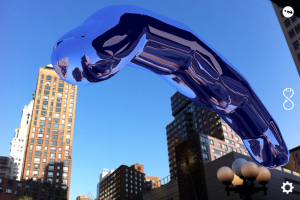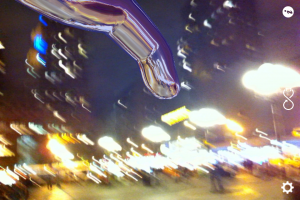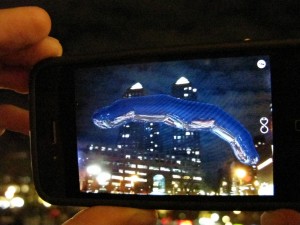Posts from April 2011.
Description of app in the AppStore
The Digit is a virtual sculpture of George Washington’s index digit, located in Union Square, NYC. You can use this application to view it.
Here is how:
If you are in the south side of Union Square, launch the app and look up. The Digit should appear in the open area near the southern tip of the square.
If you are not in Union Square and want to see the sculpture, you are able to do so vie the settings menu.
Some Extra Info:
The Digit is a response to two specific public art works located in Union Square – the statue of George Washington (the first public sculpture in New York since the statue of King George III) and Metronome – a recent installation about the city’s pacing of time that occupies 3 building facades just south of the square. Incidentally, Metronome includes an enlarged replica of GW statue’s hand (just above the smoking hole). The Digit follows this trajectory by isolating the index digit of George Washington and appropriating it as an emblem of the digital condition.
Rough Start
Thesis Start- Slava Balasanov
ABSTRACT
Throughout my studies at ITP I have aimed at exploring new technologies and the things they are able to offer us. In the mean time, as an artist, I have started developing a visual language that refers to and reflects contemporary culture. As a final thesis I plan on creating a unified body of visual work and present it on a variety of technological platforms. These will be static images, web-based interactive moving images and augmented reality sculptures.
INTRO
One of the biggest challenges I have faced while using novel technology to make art is the ability to present and communicate content clearly. Often times in new-media art the content of the work is either the technology itself. This is a natural process of becoming acquainted with and exploring the new technology. We need to understand the potential of the technology and understand what it can offer and the kind of content it can offer. At a certain point, however, once the technology is familiar and operates in an established cultural framework, work that present the technology itself as content becomes mere novelty at best. Through this project I am trying to make the transition for the exploration of new technology toward the effective use of the technology to convey content.
BODY
The project began with exploration of the augmented reality technology for the iphone. I have built a prototype application to test a simple augmented reality scenario – the user launches the application and is able to observe 3d objects floating in space around him/her through the iphone’s camera feed. As a test object I used a 3d model of a nude reclining woman positioned upright, so some content exterior to the technology itself was present, however, not very well developed. The reaction of users that have tested the applications was very strong. The idea of seeing virtual objects integrated with the surrounding space using the iphone was very effective. The technology enabled simple, common-place interaction – pointing the iphone camera in various directions. It is mobile and common place, yet what it offers is very novel. By now many of us have seen augmented reality examples that use goggles or desktop computers and markers. Yet having a simple way of visualising virtual objects in any environment with your phone opens up the possibilities tremendously. However the question of content becomes immediately apparent. There are already applications that use augmented reality – ‘yelp’ points you to the closest restaurant, ‘look up’ is a game where you get to shoot virtual UFOs. With the current pace of advancement things don’t stay novel for very long, yet the question of how to use the technology in an effective and interesting way is not solved very easily.
The content of the original application, despite not being fully developed, was none the less successful. The 3D ‘goddess’ (as I like to call her) emphasized the connection between the augmented reality technology and its cultural implications. A reflective white cg material was evocative of Greek sculptures and their celebration of the human body. Yet the large solid physical object of the statues has been replaced here with a virtual one, something emblematic of the digital age. This symbol, in turn, draws our attention back to the technology we are using to view the virtual object, thus completing the circle. As we contemplated the 3d goddess, we are faced with the realisation that the divide between the virtual and the ‘real’ is rapidly shrinking.
Ok… so its shrinking… But what now?
I was interested in pursuing working with augmented reality, but I now needed to find content that would put less emphasis on the technology. I wanted to develop a more sophisticated visual aesthetic suitable for the medium. I was inspired by recent developments in internet art aesthetic. In the past 15 years net.art has undergone a transformation from internet technology as content to internet culture as content. In particular, recent work has isolated purely visual language of the net. Since mobile devices are in many ways an extension of the internet it made sense to connect the two ideas. I decided to take a step back from augmented reality and participate in the net.art dialogue. I first I wanted to create a set of static images to explore the aesthetic and participate in the net.art dialogue. Then develop animated version as webgl.


